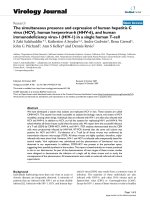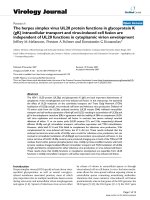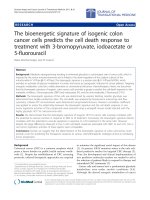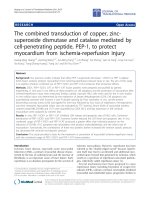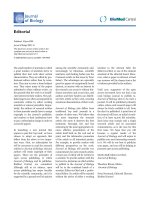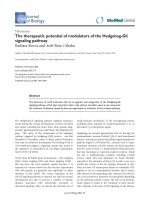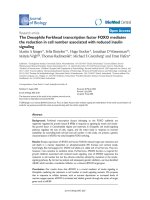Báo cáo sinh học: "The ‘stem cell’ concept: is it holding us back" pptx
Bạn đang xem bản rút gọn của tài liệu. Xem và tải ngay bản đầy đủ của tài liệu tại đây (245.84 KB, 6 trang )
Lander: Journal of Biology 2009, 8:70
Abstract
Developmental biology, regenerative medicine and cancer
biology are increasingly occupied with the molecular charac teri-
zation of stem cells. Yet recent work adds to a growing body of
literature suggesting that ‘stemness’ cannot be reduced to the
molecular features of cell types, and is instead an emergent
property of cell lineages under feedback control.
Great concepts in science do not just happen. They evolve,
often along predictable lines. In an especially common
scenario, an orderly set of related observations leads
scientists to postulate an abstract entity or class whose
existence somehow explains those relationships. Later on,
the entity gets an unambiguous operational definition,
through the application of some generally accepted experi-
mental test. Frequently, in a third and final stage, the
experimental test is replaced by a set of concrete features,
typically physical, that more efficiently (if some times a
little imperfectly) characterize the concept.
As an illustration of this progression, consider the concept
‘gene’. The idea that inherited traits might be passed from
parent to offspring through discrete units first led to
abstract notions of some sort of ‘unit of heredity’. Later,
tests based on breeding and recombination allowed such a
unit to be operationally defined in a rigorous (if sometimes
laborious) way. Eventually, alternative definitions based
on the physical characteristics of genes began to supplant
such tests, so that most modern biologists now see genes as
stretches of DNA with particular sequence characteristics,
which happen to control inheritance (as opposed to units
of heredity that happen to be instantiated in DNA).
Evidence that this more physical definition of the gene has,
for all practical purposes, replaced the one based on the
operation of breeding can be seen in how readily we accept
gene annotations for organisms, such as mammoths [1],
which we could never actually breed.
Of course, not all scientific concepts get reduced to purely
physical characteristics. But in the natural sciences, and
especially biology, concepts that cannot be recast in this
way often fail to develop much traction. One reason is that,
to get a lot of use out of a concept, we need to be able to
recognize quickly and easily what it refers to (we cannot
afford to set up crosses every time we want to call
something a gene). There is an even more compelling
reason: history tells us that it is often only in the act of
searching for the physical equivalents of abstract notions
that we tend to learn whether those abstractions refer to
anything real at all. As a case in point, consider ‘phlogiston’,
an idea introduced in the seventeenth century to explain
the process of combustion. The concept of phlogiston
admits precise operational definition - it is the substance
universally removed from all materials upon burning - but
it happens that no substance with definite physical charac-
teristics has ever been found that satisfies this operational
definition. Indeed, it was ultimately the discovery that one
of those physical characteristics would need to be the
unlikely property of ‘negative mass’, which consigned
phlogiston to the conceptual discard pile.
Evolution of the stem cell concept
Like gene or phlogiston, the term ‘stem cell’ is a scientific
concept. Stem cells are very much in the news, thanks to a
dramatic upsurge in interest in their therapeutic potential.
The recent discovery that stem cell behaviors can be
acquired by ordinary cells following the introduction of a
small number of genes (reviewed in [2]) has intensified
such interest. At the same time, the finding that only a
small fraction of the cells within malignant tumors can
initiate new tumors upon transplantation has led many
cancer biologists to embrace the notion that stem cells are
the driving force behind malignancies, and to advocate
redirecting cancer therapy toward controlling or eradica-
ting stem cells (reviewed in [3]). Clearly, we live in an era
of biology when ideas and theories about stem cells are a
major part of the intellectual landscape.
Where does stem cell as a concept lie along its evolutionary
trajectory? The phrase seems to have come to us via
histologists in the nineteenth century, who introduced it as
a general, abstract term for cells specifically involved in
repair or regeneration. With the discovery in the 1950s that
bone marrow cells could reconstitute the hematopoietic
systems of irradiated individuals, the modern stem cell
concept began to crystallize around the experimental
procedures of transplantation and reconstitution. These
and other studies gave us a good and enduring operational
definition for stem cells: those cells that when introduced
Opinion
The ‘stem cell’ concept: is it holding us back?
Arthur D Lander
Address: Center for Complex Biological Systems, Department of Developmental and Cell Biology, and Department of Biomedical
Engineering, University of California at Irvine, Irvine, CA 92697-2300, USA. Email:
70.2
Lander: Journal of Biology 2009, 8:70
into a tissue depleted of its normal cells can, through
proliferation and differentiation, reconstitute that tissue.
By this analysis, the stem cell concept finished passing
through the stages of broad abstraction and precise
operational definition by the 1960s. Yet, despite no small
amount of effort since then, a subsequent stage of
evolution - in which stem cell is redefined in terms of
physical characteristics - has yet to take place. It is
perhaps curious that, after 45 years, we have been unable
to place the general notion of ‘stemness’ on a purely
molecular footing. Of course, the fact that a goal has not
been achieved after a long time does not mean that the
answer in not around the corner. But it does give one
cause to wonder whether something we are doing needs
to change, either the question we are asking or the way we
are approaching it.
Approaching stemness
So far, the main way in which researchers have sought to
get a handle on stemness has been to try to reduce stem-
cell behavior - a phenomenon operationally defined at the
level of tissues and tissue reconstitution - to a set of
necessary and sufficient, intrinsic cell-level properties. The
two properties that are universally discussed are ‘potency’
and ‘self-renewal’. Stem cells, it is said, display traits of
potency and self-renewal that set them apart from other
cells. Understanding the molecular basis of these abilities,
it is argued, should lead directly to a molecular description
of stemness. In evaluating this plan, we need ask two
questions. First, do stem cells really perform feats of
potency and self-renewal that set them apart? Second,
should we expect there to be a common molecular basis for
those behaviors?
Both of these questions are surprisingly thorny. Consider
the matter of potency: the usual definition is the ability to
generate cells of other types, but there are two problems
with this. First, there are clearly cells in the body that
generate cell types other than themselves but which are not
regarded as stem cells (for example, those that are often
called ‘committed progenitors’). We can distinguish such
cells from stem cells by requiring the latter to be at least
bi-potent (able to produce at least two cell types other than
themselves), but it is not clear that adult stem cells
necessarily have this property. And if we intend to include
cancer stem cells in our definition, we would be hard
pressed to find any good reason to demand that those cells
produce more than one type of differentiated offspring. A
converse issue arises during embryonic development,
because the vast majority of cells, at early stages at least, go
through many sequential multipotent stages. Unless we
wish to call all of them stem cells (which would seem to rob
the concept of much of its utility), we are forced to
conclude that high potency alone is an insufficiently
restrictive criterion by which to define stem cells.
The second problem with defining stem cells in terms of
potency is that traditional notions of what a cell type is,
and how cells move between types, seem to be eroding,
thanks to recent work by stem cell researchers and an
influx of ideas from systems biology. The traditional view
of cell differentiation as a set of irreversible, deterministic
transitions from one stable state to another is giving way to
a view in which cell states are quasi-stable points on an
‘energy landscape’ along which cells move in response to
both stochastic variation and external signals (see, for
example, [4-6]). By this view, potency is not really a
property that a cell has independent of its environment. A
good analogy likens cell types to metabolites in metabolic
networks. Arrow diagrams showing pathways by which
glucose can be converted into hundreds of other substances
make nice wall charts, but if one wants to say what glucose
will actually become in any real situation, one needs to
know enzyme levels and activities, levels of other metabo-
lites, temperature, pH and so forth.
From the above discussion, we might argue that a
definition of stemness based solely on potency suffers from
being either too restrictive, too inclusive or too unhelpful.
Of course, this does not stop us from adopting a definition
that combines potency with some other property, such as
self-renewal. Indeed, this seems to be the position that
most stem cell researchers currently adopt.
Unfortunately, self-renewal is an even more slippery
notion than potency. To begin with, the most self-evident
meaning of this phrase - making more of one’s self - is
clearly not what is meant when it is used in the stem cell
field. Even terminally differentiated cells (as long as they
are not post-mitotic) are self-renewing in this sense.
Rather, what is generally meant by self-renewal is that
stem cells maintain their own numbers at the same time as
they are producing cells of other types. A more accurate, if
cumbersome, phrase might be ‘numerical homeostasis in
the face of constant differentiation’.
On the face of it, such homeostasis is indeed a remarkable
phenomenon, and worthy of investigation. But is it a
necessary feature of stem cells? And when it occurs, can it
be reduced to a set of unique molecular characteristics?
Unfortunately, the odds that either question can be
answered in the affirmative do not look good.
To begin with, the only stem cells for which we can expect to
see homeostasis of cell number are those of mature tissues
(so-called ‘adult’ stem cells). During embryonic development
we should want stem cell populations to grow over time.
Likewise, cancer stem cell populations, by the very defini-
tion of cancer, expand. So strict adherence to homeostasis
would eliminate from consideration too many of the cells we
would like to include as stem cells. Yet even if we restrict
ourselves to adult stem cells, we still run into problems. To
70.3
Lander: Journal of Biology 2009, 8:70
see why, it is helpful to think about the possible mechanisms
by which homeostasis might be achieved.
The first such mechanism is for every stem cell to undergo
obligatory asymmetric division. According to this model,
when a stem cell divides, one daughter differentiates and
one remains a stem cell. The alternative model, sometimes
referred to as ‘stochastic differentiation’, has stem cells
making a mixture of asymmetric divisions and symmetric
ones, the latter producing either two stem cells (symmetric
renewal), or two differentiated cells (symmetric differentia-
tion). In this case, homeostasis is achieved if, and only if,
the two types of symmetric divisions occur with exactly
equal probabilities. The need for exact balance is under-
scored by the simple calculation that a mere 10% deviation
from equality would, if sustained, cause the stem cells in a
tissue to either expand indefinitely or vanish, with a
doubling (or halving) time of about seven cell cycles.
Traditionally, the all-asymmetric-division model is seen as
the simpler of the two, and it is certainly the more popular
in textbooks. The suggested mechanism is that stem cells
distribute different cytoplasmic ‘determinants’ to their
apical and basal ends. By constraining cell division planes
to lie perpendicular to the apico-basal axis, determinants
of stemness necessarily pass to just one of the two daughter
cells. The major difficulty with this model is that it works
too well: if stem cell populations are ever to expand (for
example, during embryonic development), there needs to
be some way either to shut off the differential sorting of
determinants, or reorient planes of cell division.
The benefits of feedback
Just as the difficulty with the all-asymmetric division
model is getting it to do anything other than homeostasis,
the perceived difficulty with the stochastic model has
always been in getting it to achieve homeostasis at all.
Specifically, how could a population of individual, stochas-
tically-acting cells assure that their rates of renewal and
differentiation are exactly balanced?
Interestingly, this problem has recently been solved, and
the answer is simplicity itself: all that is required is for the
descendants of stem cells to release a substance that
accumulates according to their abundance, and feeds back
to decrease the renewal probability of stem cells (that is,
increase the fraction of stem cell progeny that differen-
tiate). As the consequence of an engineering principle
known as ‘integral feedback control’, an exact balance of
renewal and differentiation automatically occurs, regard-
less of how the feedback substance works, how much of it
is made or how sensitive cells are to it [7].
In fact, research showing that self-maintaining tissues do
release feedback regulators (chalones) goes back to the
1950s, and received a big boost in the 1990s with the
discovery of myostatin and its role as a feedback controller
of muscle growth [8]. Since then, several other chalones
have been identified in various tissues, many of which, like
myostatin, are members of the TGFβ family of growth
factors. Although it was originally thought that chalones
acted by regulating the rates at which cells divide, recent
work in olfactory epithelium [7] and muscle [9] shows that -
just as is needed by the stochastic differentiation model -
they also decrease the probability that stem and progenitor
cell progeny remain at the stem or progenitor cell stage
(that is, they increase the probability of differentiation).
Thus, the machinery for achieving stem cell-driven tissue
maintenance in the face of stochastic stem cell behaviors is
clearly implemented in at least some tissues.
The jury is still out on whether all self-maintaining tissues
exploit stochastic renewal with feedback or whether some,
do in fact rely on invariant asymmetric stem cell divisions.
A strong prediction of the stochastic model is that even in
the face of homeostasis, every stem cell pedigree has a non-
zero probability of going extinct. By pedigree I refer here to
a stem cell and its (non-stem cell) descendants, all of which
would be doomed to disappear whenever their stem cell
ancestor undergoes symmetric differentiation. In fact,
periodic random extinction (balanced by an equal rate of
pedigree duplication when stem cells undergo symmetric
renewal) provides one of the most plausible explanations
for the extremely high variability commonly seen in the
sizes of stem cell-derived clones in vivo [10,11]. Other
kinds of experimental data also support the occurrence of
pedigree extinction, sometimes also referred to as ‘niche
succession’ (see, for example, [12,13]). The main problem
with such extinctions, in theory at least, is that they make it
easy for pathologically ‘advantaged’ stem cells (for
example, ones that have, through mutation, become faster
-growing or less susceptible to feedback control) to displace
normal ones. The preference for asymmetric division by
stem cells that is observed in many tissues might well have
arisen as a protective mechanism to minimize this effect.
Put another way, the fact that stem cells very often do
divide asymmetrically in no way implies that asymmetric
division is the mechanism of tissue homeostasis. One can
achieve homeostasis through feedback control, and still
expect to see frequent (albeit not obligatory) asymmetric
division, especially in tissues with rapid turnover in which
stem cells must divide many times during the lifetime of
the organism.
The control of stem cell behaviors through feedback
regulation of self-renewal is impressive not only for the
ease and flexibility with which it achieves homeostasis, but
even more so for what it accomplishes under other circum-
stances: when tissues are away from equilibrium (that is,
have more or fewer differentiated cells than the level at
which homeostasis would be achieved), the alteration in
feedback causes stem cell populations to either expand or
70.4
Lander: Journal of Biology 2009, 8:70
contract exponentially - producing a remarkably rapid
return toward equilibrium [7,14]. This phenomenon explains
many dynamic features of tissue growth and regeneration.
For example, during regeneration it is common to observe
progenitor pools transiently expand and contract, the latter
occurring in concert with the reappearance of differen-
tiated cells. In developing tissues, expanding and contract-
ing progenitor pools are also commonly observed, and in at
least one case the self-renewal probabilities of progenitors
have been measured and found to decline continuously as
differentiated cells appear [15]. All these behaviors are
predicted by feedback regulation models [7,14]. Such
models also show how oscillations easily emerge in the
production of differen tiated cells (such as are observed in
the hair cycle, and in certain hematopoietic and immune
conditions) [14], and explain why stem cell numbers self-
regulate (for example, why one can introduce large
numbers of additional embryonic stem cells into a mouse
blastocyst yet end up with a normal mouse). Finally,
feedback control provides a general explanation for why
stem cells seem to behave homeostatically only in their
normal in vivo context (an idea, which suggests that a stem
cell’s ‘niche’ may not just be an environment in which it
thrives, but also one in which it can exercise its own
potential for self-control).
Do principles of control define a unique class
of cells?
The fact that so many characteristic behaviors of stem cells
and stem cell systems - homeostasis in the face of the
production of differentiated progeny; rapid tissue regenera-
tion; developmental expansion; self-regulation; and niche
dependence - emerge simply as a result of feedback
regulation of self-renewal suggests that the ability to be
regulated by such feedback might serve as a good defining
characteristic of stemness. Alas, we have no such luck here.
As it happens, cells that are not considered stem cells also
show this behavior, namely the so-called ‘transit amplifying
cells’ that lie downstream of stem cells in tissue lineages,
and are distinguished by an apparently limited potential
for self-renewal. For example, in the olfactory epithelium,
qualitatively similar feedback effects are mediated by two
different TGFβ family members upon the stem cell and its
molecularly distinct descendant, respectively [7]. That
descen dant, the immediate neuronal progenitor, behaves
like a typical committed progenitor, generally self-
renewing only a few times before differentiating [16].
In fact, it is probably no accident that, even within a single
lineage, both stem and transit amplifying cells are subject
to the same sort of feedback regulation. To see why,
consider the diagram in Figure 1, which depicts a three-
stage lineage progressing from what might be a stem cell
(type 0) to a transit amplifying cell (type 1), to a post-
mitotic differentiated cell (type 2). Each dividing cell type
is characterized by an intrinsic probability of renewal, p,
which quantifies that overall fraction of its progeny that
remains at the same lineage stage, and by a feedback gain
g, which quantifies how the cell’s actual renewal probability
declines with the number of terminally differentiated cells
in its vicinity. Consider now the case when both p
0
and p
1
are greater than 0.5; that is, the intrinsic tendency of both
type 0 and type 1 cells is to renew more than half the time,
and it is only feedback that restrains them from doing so.
Depending on the values of the p- and g-parameters, this
system will behave in one of two ways.
In one parameter regime - when the amount of feedback
needed to lower the renewal behavior of cell type 0 to 50%
is sufficient to drive that of cell type 1 below 50% - the
system will achieve a stable steady state in which cell type
0 maintains its numbers homeostatically and cell type 1
displays frequent random extinctions. Unless one is look-
ing closely at the statistics of such events, the behavior of
cell type 1 will suggest that it has only a limited, relatively
fixed potential to self-renew.
In the other parameter regime - in which the amount of
feedback needed to lower the renewal behavior of cell type
0 to 50% is not sufficient to drive that of cell type 1 to 50% -
Figure 1
Feedback produces stem cell and transit amplifying cell behaviors.
A two-stage cell lineage is shown, in which cells of type 0 and type
1 divide (at rates v
0
and v
1
, respectively), and produce progeny with
an intrinsic probability (p
0
or p
1
, respectively) of remaining at the
same lineage stage (as opposed to differentiating to the next one).
Cell type 2 is terminally differentiated, and dies (or is shed) at rate
d. As long as p
0
> 0.5, any negative feedback (schematized by solid
red lines, and quantified by parameters g
1
and g
2
) from cell type 2
onto p
0
forces the system to reach a self-maintaining steady state. If
there is feedback onto both p
0
and p
1
, the quantitative details
determine whether cell type 0 behaves like a stem cell and cell type
1 like a transit amplifying cell; or whether cell type 1 behaves like a
stem cell and cell type 0 goes extinct. If feedback also slows cell
division (for example, v
0
, dashed red line), more complex system
behaviors may occur (for example, in which cell type 1 normally
fulfills most stem cell functions, with cell type 0 remaining quiescent
except following tissue injury, when it transiently ‘reawakens’). For
further details see [7,14,17].
0 1 2
p
0
p
1
v
0
v
1
d
g
0
g
1
70.5
Lander: Journal of Biology 2009, 8:70
something completely different will happen. Cell type 0
will be driven to extinction, and cell type 1 will be driven to
homeostasis.
In other words, which cell becomes the stem cell in this
simple system is just a matter of parameter values, nothing
more [7,14,17]. And since these values depend on things
like the numbers of differentiated cells and the amounts of
the various feedback factors they produce, we would have a
hard time avoiding the conclusion that it is cellular context,
not intrinsic molecular specification, that establishes
whether a cell type becomes a stem cell, a transit
amplifying cell or simply goes extinct.
Beyond stemness?
The view that stem cells are not fixed in their proliferative
behaviors reinforces suggestions by others - mostly
motivated by the problems that arise when trying to define
stem cells in terms of potency - that the term stem cell
properly applies only to ‘condition’, not ‘character’ [18,19].
If this is really the case, what does it say about the many
attempts over the years to define stemness in terms of
molecular properties?
Above all, it suggests that stemness is a property of
systems, rather than cells, with the relevant system being,
at minimum, a cell lineage, and more likely a lineage plus
an environment. A system with stemness is typically one
that can achieve a controlled size, maintain itself homeo-
statically, and regenerate when necessary. Moreover, it
most probably does so by exploiting basic principles of
feedback control.
If stemness is a system-level property, then the concept of
stem cell is really fundamentally different from that of, say,
gene. A more similar concept might be something like
‘rate-limiting enzyme’, which also defines a class of
tangible, physical objects, but only does so in terms of their
functional roles within a system, not their intrinsic
biochemical properties.
The assertion that the stem cell concept cannot be reduced
to the molecular properties of individual cells is more than
just an esoteric philosophical stance; it has important
practical ramifications. For one thing, it suggests that the
kind of molecular understanding that researchers most
urgently need to pursue is of basic cellular phenomena
that, while not unique to stem cells, are critical for stem
cell function: for example, the ability of daughter cells to
take on fates different from their mothers; the ability of
sister cells to take on fates different from each other; and
the ability of external cues to regulate both of these
properties.
For another, the observation that stem cell behaviors can
emerge as a consequence of feedback control calls attention
to the fact that stem cell systems are, fundamentally,
dynamical systems. Their behaviors can be complex and
counterintuitive, yet ultimately still understandable,
especially with the help of modeling or simulation. Given
that lineage relationships and feedback configurations can
be far more elaborate than those shown in Figure 1,
concerted efforts are needed to elucidate the classes of
dynamical behaviors of which stem cell systems are
capable. For example, in the case of cancers that are stem
cell driven, it is not clear that we actually have grounds to
assume that the specific chemotherapeutic targeting of
cancer stem cells will necessarily stop tumors in their
tracks. Indeed, if feedback and lineage progression con-
tinue to take place in cancerous tissues, we might observe
that, under different conditions - different stages of
tumori gensis, different parts of a tumor, different amounts
of tumor cells - different cell types will assume the role of
'cancer stem cells'. The therapeutic implications of this
possibility are clearly substantial.
In summary, it would seem that the concept of stem cell
indeed has the potential to hold us back - especially if we
focus on demanding from it things it cannot give. But if we
can re-fashion our thinking at a different level - in which
systems relationships and dynamics take the place of
molecular signatures and simple gene regulatory circuits -
then there is a chance that the concept of stem cell will
continue to light the path toward biological understanding.
Acknowledgements
I thank Anne Calof, John Lowengrub, Qing Nie and Fred Wan for
helpful discussions. Some of the themes discussed in this piece
have also been articulated by others, and I regret that, because of
space constraints, it was not possible to cite all of the relevant
literature.
References
1. Miller W, Drautz DI, Ratan A, Pusey B, Qi J, Lesk AM, Tomsho
LP, Packard MD, Zhao F, Sher A, Tikhonov A, Raney B,
Patterson N, Lindblad-Toh K, Lander ES, Knight JR, Irzyk GP,
Fredrikson KM, Harkins TT, Sheridan S, Pringle T, Schuster
SC: Sequencing the nuclear genome of the extinct woolly
mammoth. Nature 2008, 456:387-390.
2. Jaenisch R, Young R: Stem cells, the molecular circuitry of
pluripotency and nuclear reprogramming. Cell 2008, 132:
567-582.
3. Marotta LL, Polyak K: Cancer stem cells: a model in the
making. Curr Opin Genet Dev 2009, 19:44-50.
4. Enver T, Pera M, Peterson C, Andrews PW: Stem cell states,
fates, and the rules of attraction. Cell Stem Cell 2009, 4:387-
397.
5. Chang HH, Hemberg M, Barahona M, Ingber DE, Huang S:
Transcriptome-wide noise controls lineage choice in mam-
malian progenitor cells. Nature 2008, 453:544-547.
6. Chuong CM, Widelitz RB: The river of stem cells. Cell Stem
Cell 2009, 4:100-102.
7. Lander AD, Gokoffski KK, Wan FY, Nie Q, Calof AL: Cell line-
ages and the logic of proliferative control. PLoS Biol 2009,
7: e15.
8. Lee SJ, McPherron AC: Myostatin and the control of skeletal
muscle mass. Curr Opin Genet Dev 1999, 9:604-607.
9. Manceau M, Gros J, Savage K, Thome V, McPherron A, Paterson
B, Marcelle C: Myostatin promotes the terminal differentia-
70.6
Lander: Journal of Biology 2009, 8:70
tion of embryonic muscle progenitors. Genes Dev 2008, 22:
668-681.
10. Till JE, McCulloch EA, Siminovitch L: A stochastic model of
stem cell proliferation, based on the growth of spleen col-
ony-forming cells. Proc Natl Acad Sci USA 1964, 51:29-36.
11. Mangel M, Bonsall MB: Phenotypic evolutionary models in
stem cell biology: replacement, quiescence, and variabil-
ity. PLoS ONE 2008, 3:e1591.
12. Jordan CT, Lemischka IR: Clonal and systemic analysis of
long-term hematopoiesis in the mouse. Genes Dev 1990, 4:
220-232.
13. Kim KM, Shibata D: Methylation reveals a niche: stem cell
succession in human colon crypts. Oncogene 2002, 21:
5441-5449.
14. Lo WC, Chou CS, Gokoffski KK, Wan FY, Lander AD, Calof AL,
Nie Q: Feedback regulation in multistage cell lineages.
Math Biosci Eng 2009, 6:59-82.
15. Takahashi T, Nowakowski RS, Caviness VS Jr: The mathematics
of neocortical neuronogenesis. Dev Neurosci 1997, 19:
17-22.
16. Wu HH, Ivkovic S, Murray RC, Jaramillo S, Lyons KM, Johnson
JE, Calof AL: Autoregulation of neurogenesis by GDF11.
Neuron 2003, 37:197-207
17 Johnston MD, Edwards CM, Bodmer WF, Maini PK, Chapman
SJ: Examples of mathematical modeling: tales from the
crypt. Cell Cycle 2007, 6:2106-2112.
18. Zipori D: The nature of stem cells: state rather than entity.
Nat Rev Genet 2004, 5:873-878.
19. Loeffler M, Roeder I: Tissue stem cells: definition, plasticity,
heterogeneity, self-organization and models - a conceptual
approach. Cells Tissues Organs 2002, 171:8-26.
See other regeneration and stem cells articles
and />Published: 21 September 2009
doi:10.1186/jbiol177
© 2009 BioMed Central Ltd
